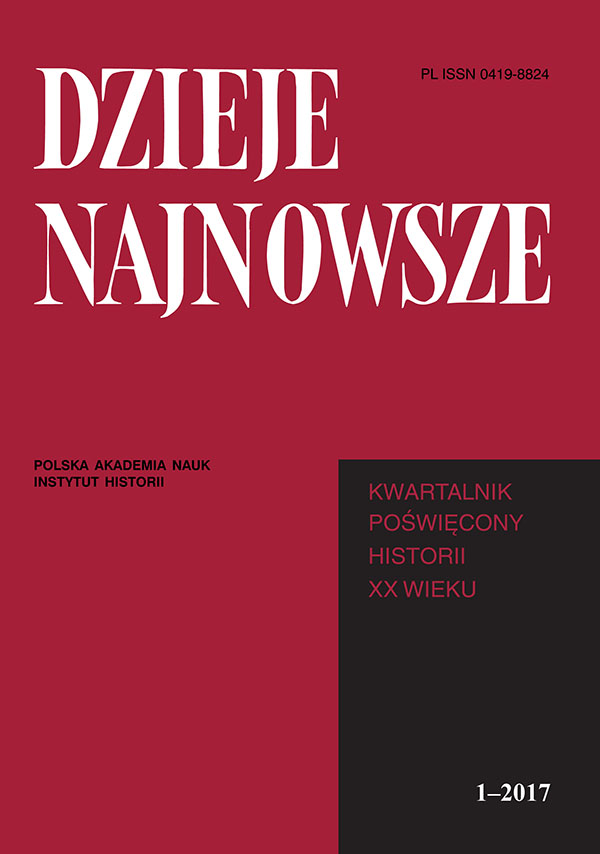„Misja na Wschodzie”. Z historii działalności Związku Dziewcząt Niemieckich (BDM) w Kraju Warty (1940–1945)
DOI:
https://doi.org/10.12775/DN.2017.1.04Słowa kluczowe
BDM, BDM-Osteinsatz, niemiecka „misja na Wschodzie”, Kraj Warty, niemiecka okupacja Polski 1939–1945Abstrakt
Artykuł prezentuje jedną form działalności Niemieckiego Związku Dziewcząt (BDM) w czasie II wojny światowej, a mianowicie program „misji na Wschodzie” (BDM-Osteinsatz). Wspomniany problem przedstawiony został na przykładzie Kraju Warty – największej jednostki terytorialnej utworzonej przez Niemców na wcielonych do III Rzeszy terenach polskich.
We wprowadzeniu do rozważań omówiono specyfikę niemieckiego „mitu Wschodu” oraz jego rolę w edukacji młodzieży w nazistowskiej Rzeszy. Następnie ukazano przyczyny i okoliczności zainicjowania programu „misji na Wschodzie” przez kierownictwo Związku Dziewcząt Niemieckich. W centralnej części artykułu zaprezentowano główne formy aktywności uczestniczek BDM-Osteinsatz – pracę z niemieckimi przesiedleńcami z Europy Wschodniej (deutsche Umsiedler) oraz członkami przedwojennej mniejszości niemieckiej w Wielkopolsce (Volksdeutsche). W tej części tekstu ukazano także stosunek uczestniczek programu do polskiej i żydowskiej ludności w Kraju Warty.
W podsumowaniu dokonano analizy roli programu „misji na Wschodzie” w niemieckiej polityce okupacyjnej na ziemiach polskich. W epilogu przedstawiono również powojenny stosunek uczestniczek BDM-Osteinsatz do ich działalności w ramach programu.
“Mission to the East”. From the history of the activity of the League of German Girls (BDM) in the Wartheland (1940–1945)
The article presents one of the forms of the activity of the League of German Girls (BDM – Bund Deutscher Mädel), i.e. the carrying out of the programme “Mission to the East” (BDM-Osteinsatz) during the Second World War. The geographical scope of the study spans the territory of the Reichsgau Wartheland – the biggest among the districts established on the Polish lands incorporated directly to the Third Reich.
The introduction to the article shows the specificity of German “Myth of the East”, as well as its role in the education of the youth in Nazi Germany. The following part of the text presents the creation and the organization of the BDM-Osteinsatz in the Wartheland. The article focuses on the main activities of the participants of the “Mission to the East“ – the work with the German people displaced by the Nazi authorities from the Eastern Europe and with the representatives of German pre-war minority in Poland (Volksdeutsche). This part of the text presents also the attitudes of the BDM-members towards the Polish and Jewish population in the Wartheland. The summary of the article contains the elaboration of the role of the BDM-Osteinsatz in the German occupation policy on the Polish territories, as well as the post-war ways of the judgement of the “Mission to the East” by its participants.
Bibliografia
Aubert K., Eine Familie im deutsch-polnischen Grenzgebiet 1897–1945, wyd. 2, München 2012.
Breitinger H., Als Deutschenseelsorger in Posen und im Warthegau 1934–1945. Erinnerungen, Mainz 1991.
Die BDM-Generation. Weibliche Jugendliche in Deutschland und Österreich im Nationalsozialismus, red. D. Reese, Berlin 2007.
Epstein C., Wzorcowy nazista. Arthur Greiser i okupacja Kraju Warty, tłum. J. Włodarczyk, Wrocław 2010.
Finckh R., Sie versprachen uns die Zukunft. Eine Jugend im Nationalsozialismus, Tübingen 2002.
Friese H., Unsere Siedler im Kreis Wielun, [b.m.w.] 1965.
Fritsch H., Land mein Land (Bauerntum und Landdienst, BDM-Osteinsatz, Siedlungsgeschichte im Osten), Schutz 1986.
Geisler W., Deutscher! Der Osten ruft dich!, Berlin 1941.
Harten H.Ch., De-Kulturation und Germanisierung. Die Nationalsozialistische Rassenund Erziehungspolitik in Polen 1939–1945, Frankfurt am Main [i in.] 1996.
Hohenstein A., Wartheländisches Tagebuch aus den Jahren 1941–1942, Stuttgart 1961.
Klaus M., Mädchenerziehung zur Zeit der faschistischen Herrschaft in Deutschland, t. II: Materialband, Frankfurt am Main 1983.
Krieger R., Deutsche Mädel im Osten, Berlin [1941].
Leniger M., Nationalsozialistische „Volkstumsarbeit” und Umsiedlungspolitik 1933–1945, wyd. 2, Berlin 2011.
Mackensen L., Sagen der Deutschen im Wartheland, Posen 1944.
Maschmann M., Bilans. Moje życie w Hitlerjugend. Bez usprawiedliwienia, Kraków 2005.
Meyer-Semlies U., Glockenläuten und Kanonendonner. Eine Kindheit und Jugend in Ostpreussen 1914–1945, Marxen 1989.
Rosen H. von, Grocholin. Geschichte eines deutschen Gutes in Posen, wyd. 2, Leer 1986.
Rüdiger J., Ein Leben für die Jugend. Mädelführerin im Dritten Reich, [Rosenheim] 1999.
Rutowska M., Wysiedlenia ludności polskiej z Kraju Warty do Generalnego Gubernatorstwa 1939–1941, Poznań 2003.
Stein E., Unser Jahr. Arbeitsmädel berichten, Berlin [1943].
Sternheim-Peters E., Die Zeit der groβen Täuschungen. Mädchenleben im Faschismus, Bielefeld 1987.
Umgesiedelt-Vertrieben. Deutschbalten und Polen 1939–1945 im Warthegau, red. E. Neander, A. Sakson, Marburg 2010.
Walb L., Ich, die Alte – ich, die Junge. Konfrontation mit meinen Tagebüchern 1933–1945, Berlin 1998.
Wiedergewonnenes deutsches Land, red. O.H. Spatz, München–Berlin 1941. Zeller E., Solange ich denken kann. Roman einer Jugend, Stuttgart 1981.
Pobrania
Opublikowane
Jak cytować
Numer
Dział
Statystyki
Liczba wyświetleń i pobrań: 540
Liczba cytowań: 0



